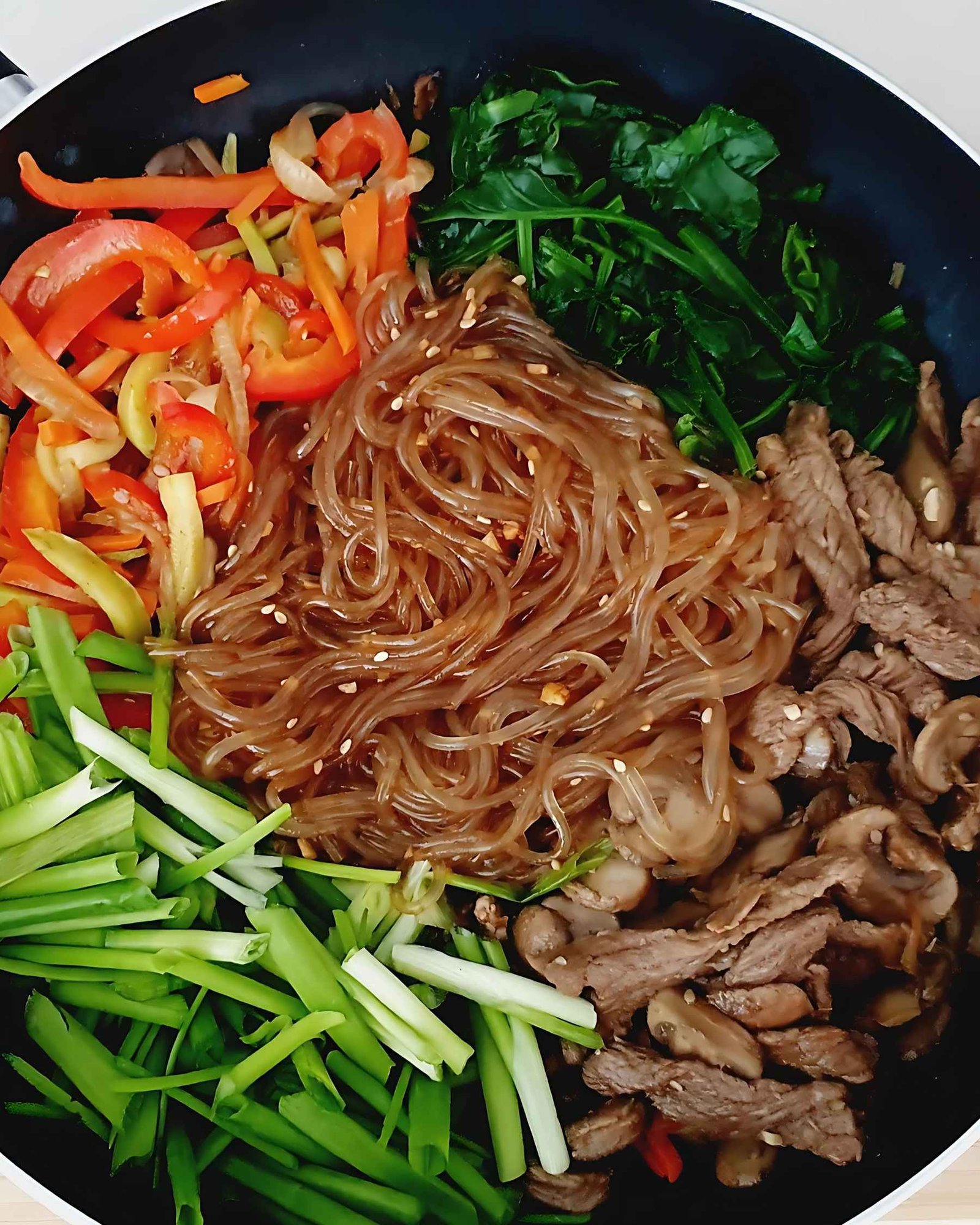
Newsletter Subscribe
Enter your email address below and subscribe to our newsletter

Enter your email address below and subscribe to our newsletter
Japchae is a traditional Korean meal made of glass noodles, also known as dangmyeon. It is a sweet potato starch type of noodle that is chewy and delicious. Everyone who has eaten Japchae has become a lifelong fan of this incredible dish. It has tangy flavors, and the rich taste of the dark soy sauce will make you want to reach for seconds.
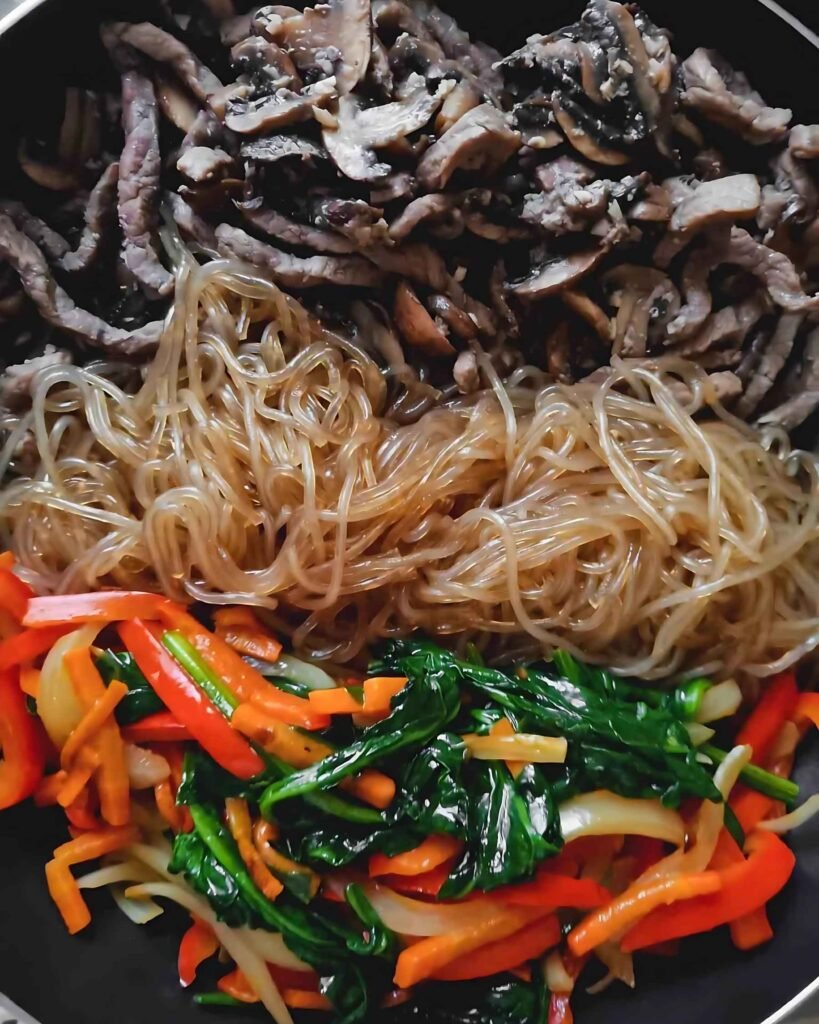
Making Japchae is like art; not everyone gets it right. For a good reason: you need to know the inside secrets to create this masterpiece. Specific steps must be followed to get it perfect.
In today’s recipe, we make Japchae faster than the traditional method. In the conventional method, each ingredient is stir-fried separately; the traditional method works if you have some spare hours and want to taste the individual flavors of each vegetable, but if you’re short on time and want to enjoy this splendid dish, make it this way. It will taste just as good.
Koreans can be meticulous when it comes to preparing the vegetables for Japchae. Each ingredient must be chopped according to specific measurements and perfectly julienned. My South Korean husband can spend roughly two hours chopping vegetables. I personally prefer the rustic approach; it’s easier, and I get to spend time on other things.
Japchae is also served at buffets and catering events as appetizers or side dishes because it can be prepared in large quantities. It is most often served as a side dish, but some people enjoy it so much that it can be served as a main meal for lunch or dinner.
Japchae uses many vegetable varieties, which gives this meal high nutritional value. Preparation time may be longer than the cooking time, but it will be well worth the effort.
It is also a balanced meal of carbohydrates, protein, vegetables, and good fat, making it perfect as a standalone meal.
Sweet potato noodle, Spinach, Mushroom, Carrot, Bell Pepper, Onion, Scallions, Beef Strips, Olive Oil, Soy Sauce, Sesame seed oil., Sugar, Salt & Pepper, Sesame seed.
Korean glass noodles are called dangmyeon. It is a translucent noodle that is made from sweet potatoes. It is a staple in Korea, and it is pretty tasty. Sweet potato noodles are different from wheat noodles. When these noodles are cooked, they absorb the flavors of the marinades and seasonings. Plus, it is gluten-free. Choose whatever vegetables you would like to add to the Japchae. Mushrooms, any variety, will do; consider white mushrooms or cremini; oyster mushrooms are also a great option. Spinach adds a tender and earthy taste. In the traditional method, the spinach is blanched. In my process, we’re skipping that step.
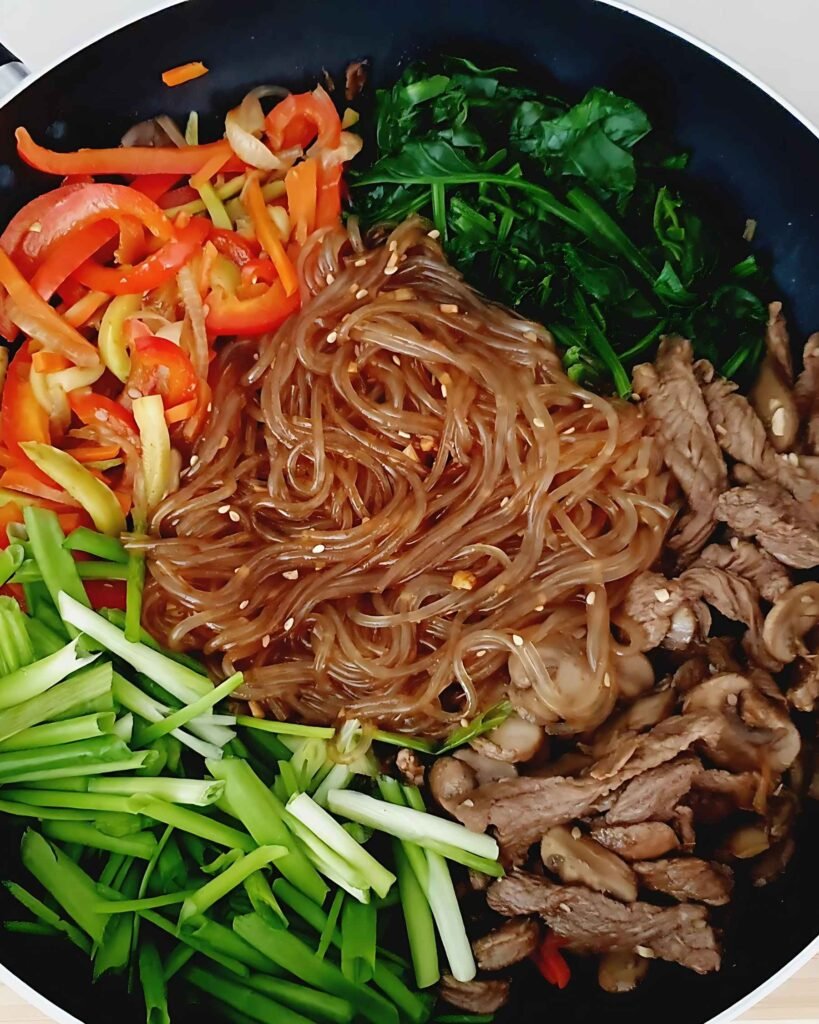
Carrots and bell peppers add crunch and texture. Sliced onions add sweetness, and scallions act as a garnish and provide a bright taste. Thinly sliced beef from ribeye or sirloin will work best; it cooks fast and remains tender. Some people choose to marinate the beef. However, if you add the marinade during the cooking process on high heat, it has a similar effect to pre-marinated beef.
The marinade combines condiments, spices, and liquids to create this dish’s sweet and savory profile. Soy sauce is this dish’s cornerstone; it gives it that rich, dark, umami taste. We chose Dark Soy sauce; it’s low in sodium and has the right saltiness to balance the sugar. For a deeper flavor and taste, choose brown sugar where possible. Sesame seed oil, the best option for this oil, comes from South Korea and Hong Kong, with Lee Kum Kee producing incredible products.
Oyster sauce is the wild card in this dish and is not traditionally used in traditional Japchae. I’m choosing to add it in for personal preference and also because it adds incredible flavour to the noodles. A tiny pinch of salt will work in each step of the process. Add it to the vegetables and taste the salt levels as you follow the instructions.
Slice the green onion to 5 cm. Slice the mushrooms into chunky bits. Peel the carrot and julienne it. Julienne, the baby marrow, bell pepper, and onion. Place the sliced onions in the preheated pan on medium-low heat. Drizzle the olive oil and cook the onion for 3-5 minutes or until caramelized.
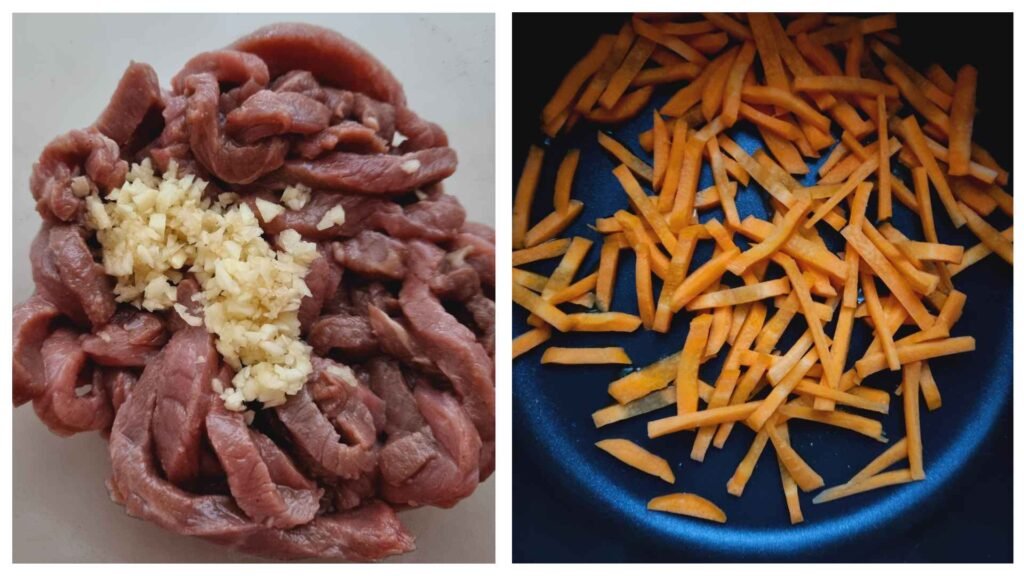
When the onion is cooked, add in the julienned bell pepper and baby marrow into the pan. Add extra olive oil and cook until baby marrow and the bell pepper becomes soft, which takes about 2-4 minutes under medium-low heat.
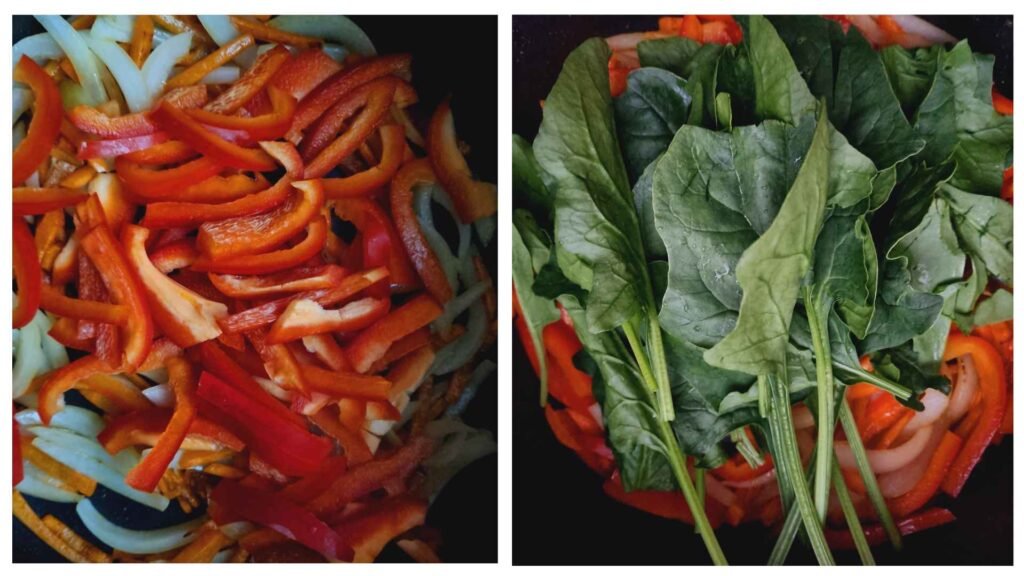
Place the sliced mushrooms and beef strips in a preheated pot at medium-low temperature. Drizzle olive oil and cook for 5-7 minutes. Sprinkle some salt and pepper while cooking them. Thinly slice the beef steak into strips. Add some soy sauce and sesame seeds and stir-fry.
Cook for five to seven minutes. Occasionally, stir the food so it is thoroughly mixed and cooked. When the mushrooms and steak are cooked, add them to the pot that contains cooked vegetables.
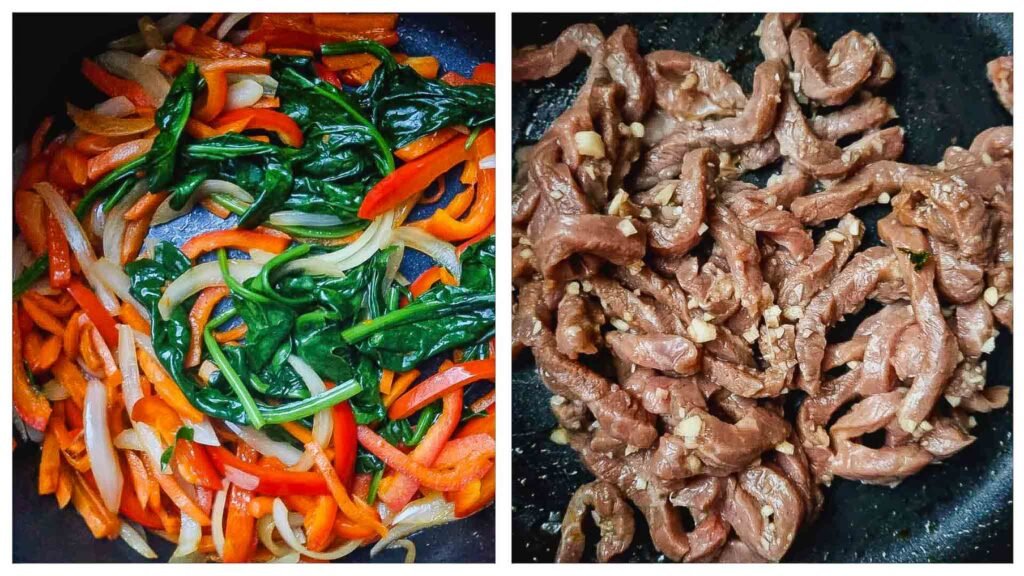
On a separate bowl, add soy sauce, water, sesame seed oil, a pinch of chili powder and sesame seeds. Stir and mix well together.
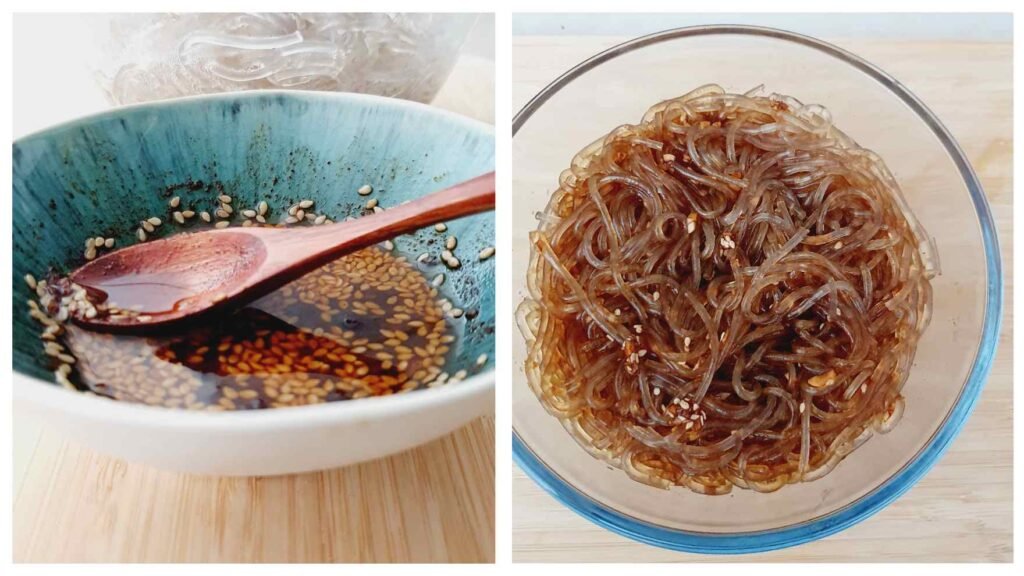
Add 1.5 liters of water in a separate pot and bring it to a boil. Add the glass noodles and cook for 8 minutes with the pot covered. Initially, stir the noodles so they don’t stick together. Rinse the noodles in cold water once cooked. Place the cooked glass noodles in a bowl. Pour the soy sauce into the bowl of glass noodles. Thoroughly mix them so that all the glass noodles have absorbed the soy sauce mix. Place the cooked vegetables on top of the soy sauce-mixed glass noodles, and mix everything well together. Sprinkle extra sesame seeds on the dish to serve.
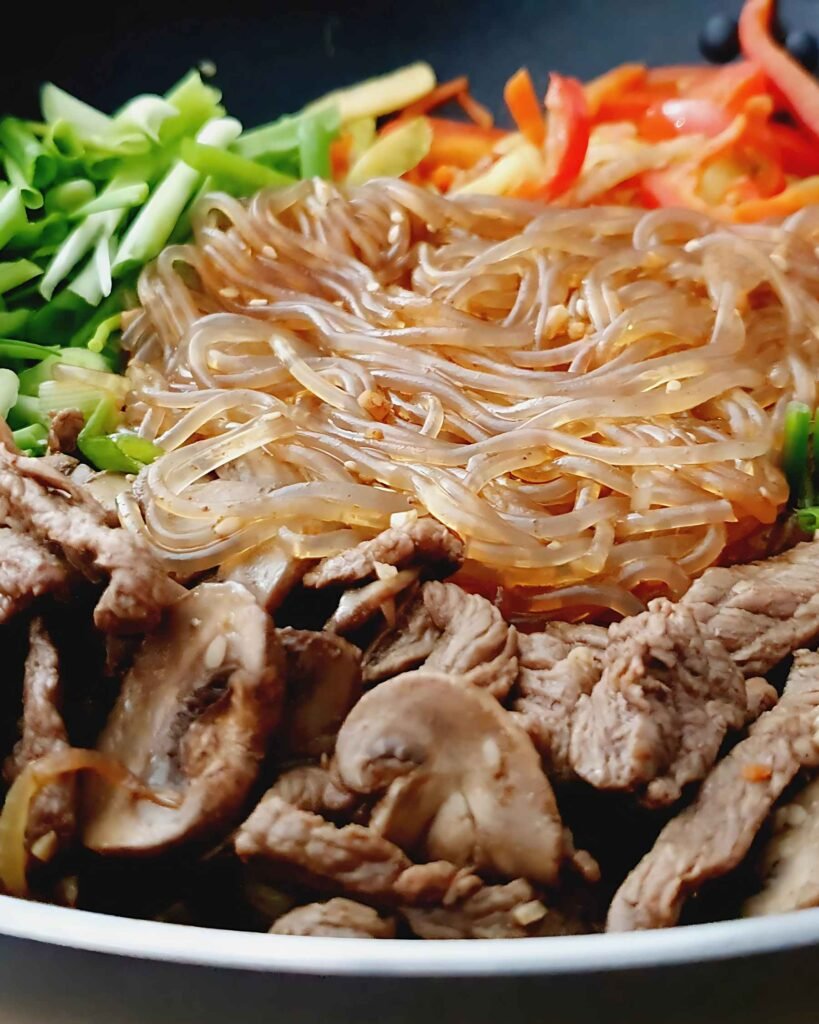
Arrange all the ingredients in your wok. Sprinkle more sesame seeds on top. Stir vigorously so that the ingredients are well mixed. Japchae has a balanced taste between sweet and savory. In this dish, sugar was omitted to enjoy the natural flavor and sweetness of the vegetables. Salt and pepper should be added in small quantities as you cook the vegetables.
You can serve Japchae with Kimchi (Korean cabbage pickle), Haemul Pajeon (Korean seafood pancake), Oi Kimchi (Cucumber salad) and Korean fried chicken.
Avoid overcooking the noodles. The chewy texture of the glass noodles is fundamental for making Japchae. Rinsing the cooked glass noodles in cold water will make them chewier, and glass noodles will easily absorb the flavour in liquid. Mixing the soy sauce marinade with cooked glass noodles separately will enhance the taste of Japchae.
Cool the Japchae completely and store in an airtight container for three to four days. Reheat in the microwave. Japchae can be frozen, although not many Koreans do this, and I haven’t tried it. The texture of the vegetables will be different. Stir-frying the carrots, bell peppers, mushrooms, and beef with 1/3rd of the recommended marinade for flavour and salt and pepper is advisable. Let it cool and freeze that portion. Make the spinach and sweet potato noodles fresh.
